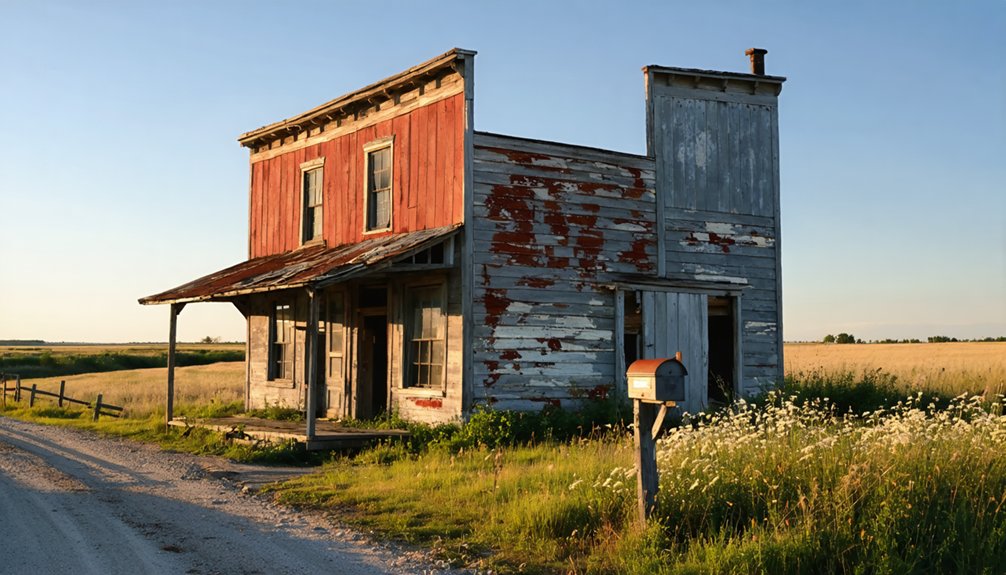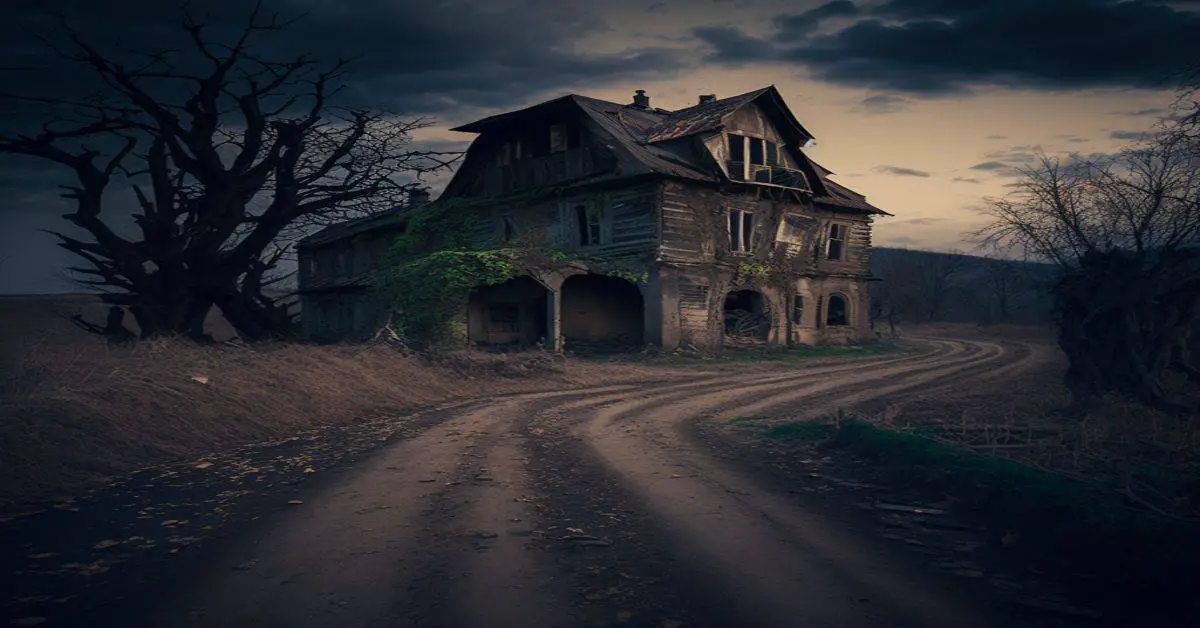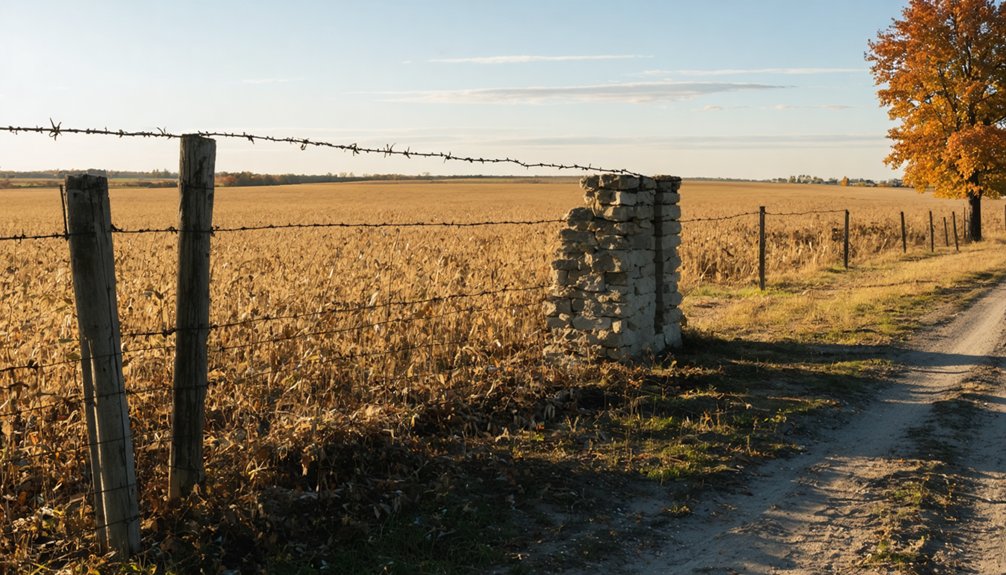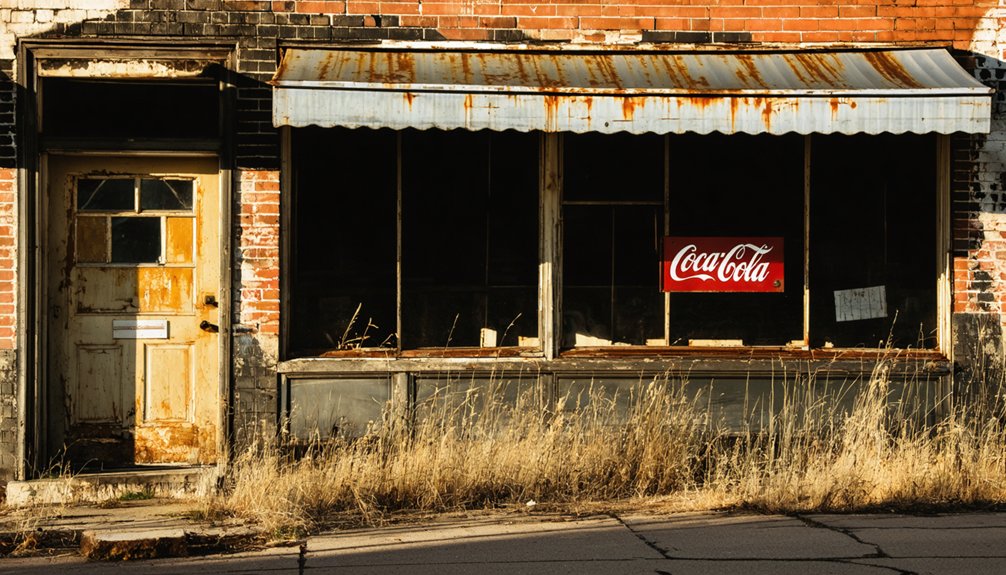You’ll discover Ledford, Illinois, as a ghost town in Saline County that was once a bustling coal mining community from the 1850s through the early 1900s. The town’s population swelled to over 1,000 residents as Hungarian immigrants worked the No. 5 and No. 6 coal seams along the Big Four Railroad. Today, only about 100 residents remain, with the historic Ledford Baptist Church and a haunting Hungarian Cemetery preserving tales of the town’s rich immigrant heritage.
Key Takeaways
- Ledford, Illinois was a thriving coal mining town that has declined to around 100 residents and is now part of Harrisburg.
- The town’s decline began in the early 1900s when thirteen major shaft mines along the Big Four Railroad ceased operations.
- Former immigrant neighborhoods, including the Hungarian district “Hunky Row,” emptied as mining jobs disappeared and families moved away.
- The Hungarian Cemetery and Ledford Baptist Church remain as historic landmarks preserving the community’s cultural heritage.
- Nature has reclaimed most of the former mining infrastructure, with only scattered homes along Highway 45 marking the town’s existence.
The Rise of a Coal Mining Community
While Native Americans likely knew of coal deposits earlier, the first documented coal discoveries in Illinois came from French explorers Marquette and Joliet in 1673 along the Illinois River.
You’ll find Ledford’s coal story beginning in the 1850s, when the region’s first slope mine opened near Ingram Hill, just south of Harrisburg.
As mining techniques evolved from surface collection to underground shaft mining by the 1870s, Ledford transformed from rural farmland into a bustling mining town.
The economic impact was dramatic – you’d have seen the population swell to over 1,000 residents as miners extracted the valuable No. 5 and No. 6 coal seams.
The town’s prosperity reflected Saline County’s dominance in Illinois coal production, which reached 41% of the state’s total output after 1925.
The Civil War helped fuel tremendous growth in both Illinois coal mining and railroad expansion throughout the region.
The Journal of Illinois published extensive historical records documenting the area’s mining heritage.
Life in the Mining Patches
If you’d lived in Ledford’s mining patches during the early 1900s, you would’ve found yourself in one of several numbered company-owned housing clusters, like the “2 patch” or “14 patch,” where miners and their families formed tight-knit communities.
Your daily life would’ve revolved around basic company-provided facilities, including a small general store where you’d use company scrip for purchases and a communal water pump shared by neighboring families.
The patches became particularly enriched by Hungarian immigrants who brought their cultural traditions, creating a vibrant community atmosphere despite the harsh mining conditions and limited amenities. Many families in these patches lived with constant worry as miners used the dangerous room and pillar method to extract coal beneath their homes. The community’s bustling energy was fueled by thirteen larger mines operating along the Big Four Railroad through Ledford.
Daily Patch Community Life
Life in Illinois mining patches during the late 1800s and early 1900s centered around a diverse tapestry of European immigrants and African Americans who shaped these company-owned communities.
Your daily life would’ve revolved around the mine’s schedule, with entire families adapting to early morning shifts and late returns. By 1900, seven major companies operated mines throughout East Peoria, providing steady employment for the patch residents.
While men worked dangerous jobs underground, women and children tended gardens, did laundry, and took on piecework to supplement household income. Many families fell into debt at company stores, forced to use company scrip instead of regular currency for their purchases.
You’d find Italian, Irish, Slovak, Russian, and Lithuanian families living in distinct ethnic enclaves, maintaining their languages and community traditions through churches, social clubs, and regular gatherings.
Despite the harsh conditions, social gatherings at local saloons, union halls, and ethnic clubs provided vital respite from the daily grind, fostering solidarity among patch residents.
Worker Housing and Facilities
Living in Ledford’s company-owned mining patches meant you’d find yourself in one of several numbered settlements, such as 2 patch, 5 patch, or 14 patch – each named after its corresponding mine.
You’d face basic housing conditions in small, utilitarian homes clustered near mine shafts and railroad lines, designed to keep you close to work. Similar to how NI ReACH housing vouchers help families today, these company homes provided essential shelter for workers.
Your daily reality would include unpaved roads, limited utilities, and modest facilities. Much like navigation guidance helps users find specific content, these numbered patches helped residents locate their homes in the sprawling mining community. The mining company’s cost-saving priorities meant cramped spaces and poor insulation against weather.
Community dependency was unavoidable – your housing was tied directly to your employment, and you’d rely on company stores for basic needs.
While some patches developed social infrastructure like churches reflecting immigrant cultures, most amenities remained minimal, reinforcing your economic reliance on the mining enterprise.
Hungarian Cultural Influences
Among the numbered patches of Ledford’s mining settlements, you’d find a thriving Hungarian enclave known locally as “Hunky Row,” where immigrant miners and their families carved out a distinctive cultural presence in early 20th-century Illinois.
Despite the dangerous conditions of mine work, Hungarian traditions flourished within this tight-knit community. You’d witness immigrant resilience through their ethnic festivals, religious gatherings at local churches, and preservation of their native language. The vibrant social scene included regular gatherings at the roller skating rink. Many immigrant wives struggled with their husbands’ name changes, as traditional Hungarian names were often Americanized over time.
Mining companies even printed safety pamphlets in Hungarian, recognizing the significant presence of these workers. The community’s strength showed in their political activism, particularly during the 1932 Progressive Miners movement.
Through marriages, cultural celebrations, and mutual support networks, Ledford’s Hungarian residents maintained their identity while adapting to life in America’s coal country.
Hungarian Heritage and Immigration Impact
During the early 1900s, a significant wave of Hungarian immigrants transformed Ledford’s demographic landscape, with census records showing 1,536 newcomers arriving in Saline County between 1900-1910.
These resilient immigrants established a vibrant community in “Hunky Row,” just south of Ledford, where Hungarian customs and immigrant stories became woven into the town’s fabric.
- Hungarian families maintained strong cultural ties while working in local coal mines
- The Hungarian Cemetery stands as a memorial to their lasting presence
- Census records reveal immigrant miners owned homes valued at $800 in 1930
- Many preserved their native language while adapting to mine operations
You’ll find their legacy lives on through preserved family names like Mallér and Dohany, while their contributions to labor movements and local commerce helped shape Ledford’s economic development during the early 20th century.
Transportation Networks and Infrastructure
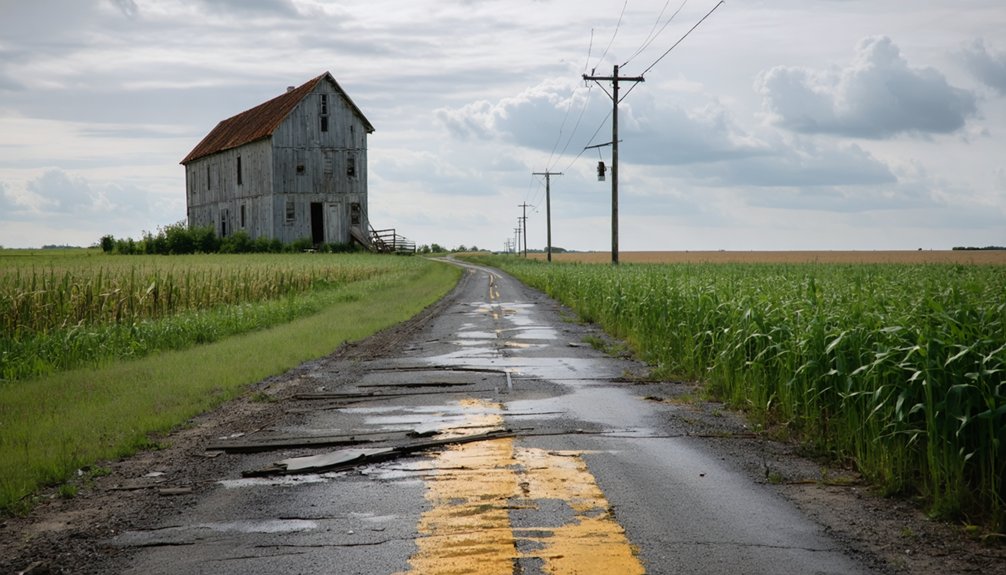
If you’d traveled through Ledford between 1913 and 1933, you would’ve found the Southern Illinois Railway & Power Co.’s interurban trolley line actively connecting the town to Harrisburg, Carrier Mills, and other mining communities.
The Cairo and Vincennes Railway, a branch of the “Big Four” (Cleveland, Cincinnati, Chicago & St. Louis Railway), served as the town’s lifeline for coal transport and passenger service until the tracks were removed in the 1980s.
After the trolley line’s closure in 1933, private bus services like the Harrisburg-Dorrisville Bus Co. became the primary public transit option, though these eventually gave way to complete dependence on personal vehicles.
Railroad and Trolley Evolution
While several railroads shaped Saline County’s development, the Southern Illinois Railway & Power Company’s interurban line played a crucial role in Ledford’s transportation network from 1913 to 1933. The trolley innovation brought reliable transit between Eldorado and Carrier Mills, connecting essential coal mining communities.
- The Big Four Railway served 13 major shaft mines, establishing Ledford’s economic foundation.
- Railroad expansion through the Illinois Central connected the region to northern markets.
- Cairo & Vincennes Railroad reached Harrisburg by 1872, enhancing regional connectivity.
- The interurban line’s heavy 70-pound rail supported both passenger and freight service.
You’ll find it fascinating how these rail systems transformed the region, with the interurban line moving up to five million tons of coal annually before automobiles and new roads led to its abandonment in 1933.
Bus Service Takes Over
After the interurban line’s closure in 1933, the Harrisburg-Dorrisville Bus Company emerged to fill the region’s transportation void, establishing regular service between the two communities.
You’ll find that these bus changes reflected a nationwide shift away from rail transport, as America’s love affair with automobiles and paved roads grew stronger.
While the bus route likely passed through Ledford, you won’t find evidence of dedicated bus facilities in the tiny community. The service operated independently of major municipal agencies, offering a modest alternative for residents as mining jobs disappeared.
Yet this transportation lifeline couldn’t halt Ledford’s decline – the community continued its quiet fade toward ghost town status, even as larger cities in Southern Illinois maintained more robust transit networks.
The Great Mining Decline
During the early 1900s, Ledford’s thriving mining economy began to falter as broader industrial changes swept through Illinois’ coal industry.
You’ll see how economic shifts transformed this once-bustling town, where over 1,000 residents called home, into a forgotten community. By the 1930s, population decline became unmistakable, with Saline County losing 3.3% of its residents.
- Thirteen major shaft mines along the Big Four Railroad ceased operations
- Immigrant neighborhoods like “Hunky Row” emptied as jobs disappeared
- Company housing “patches” around mines 2, 5, and 14 slowly emptied
- Community infrastructure – schools, churches, and businesses – vanished
Despite the community’s resilience, mechanization and competition from other regions made local mining unprofitable.
Ledford’s decline mirrored the fate of many Southern Illinois mining towns, eventually leading to its annexation into Harrisburg.
Tales From the Hungarian Cemetery
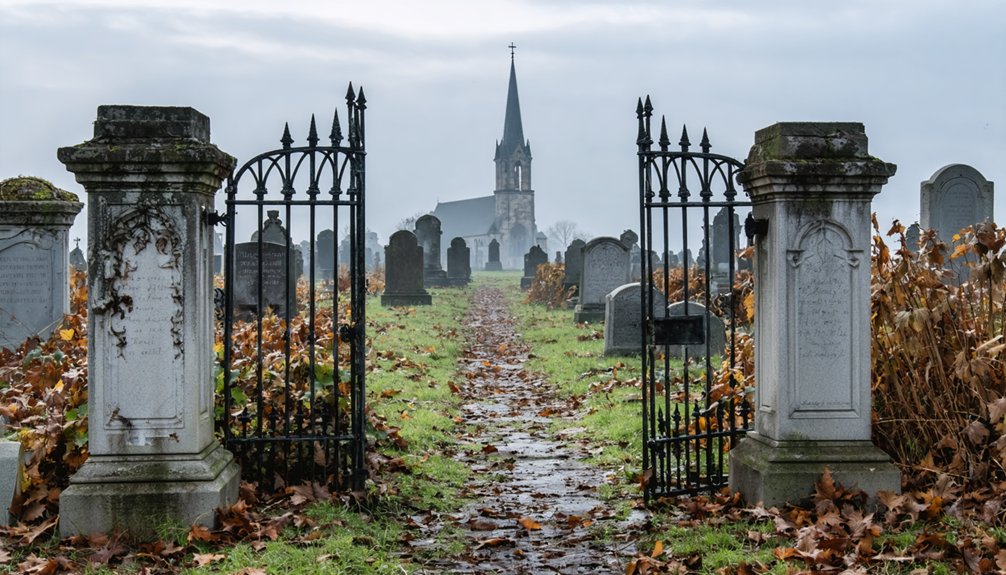
The haunting legacy of Ledford’s decline lives on in its Hungarian Cemetery, a secluded burial ground that stands as both historical monument and subject of local folklore.
You’ll find this isolated cemetery tucked away in the woods, where local ghost stories have flourished alongside the overgrown graves of early 20th-century Hungarian miners.
While reports of ghostly encounters remain largely anecdotal, the cultural significance of this burial ground can’t be understated – it’s a reflection of the immigrant experience in Southern Illinois’ mining communities.
In 2021, Lithuanian-American youth breathed new life into the neglected site, clearing brush and placing a commemorative cross.
Despite restoration efforts, you’ll still sense the weight of history here, where countless untold stories of “Hunky Row” residents and their struggles rest beneath weathered tombstones.
What Remains Today: A Ghost Town’s Legacy
While bustling coal mines once defined Ledford’s identity, today you’ll find only whispers of its industrial past along Highway 45. This ghost town‘s population has dwindled to around 100 residents, now technically part of Harrisburg, Illinois.
Yet, glimpses of community spirit endure in the structures and spaces that remain.
- The historic Ledford Baptist Church stands as a symbol of the town’s resilient faith
- A serene cemetery preserves the memories of generations past, including restored Lithuanian burial grounds
- Woods and creeks have reclaimed areas where mine shafts and coal tipples once dominated
- A scattering of modest homes lines the highway, housing families who maintain their connection to this historic place
The air’s now clean, the industrial sounds silenced – nature’s quiet return marking the end of Ledford’s mining era.
Frequently Asked Questions
What Were the Average Wages of Miners in Ledford During Peak Operations?
Like the coal dust that filled their lungs, you’d have earned $2.50-$3.50 daily during peak operations (1900s-1920s), though average miner wages later rose to $4-$6, creating significant economic impact.
Were There Any Major Mining Accidents or Disasters in Ledford’s History?
You’ll find one major disaster in the mine accident reports: the 1927 Saline No. 2 explosion killed 8 miners. Mining safety records show this was the area’s only documented large-scale catastrophe.
Did Ledford Have Its Own School System for Miners’ Children?
You’d find both parish and public schools served Ledford’s mining families, with East and West Ledford Schools providing basic education. School enrollment included miners’ children, though records don’t specify education quality details.
What Happened to the Original Ledford Family After the Town Declined?
Like dust scattered in the wind, you can’t trace the Ledford family’s fate after the town’s population decline – no records show where they relocated or if they left any lasting legacy behind.
Were There Any Notable Labor Strikes or Union Activities in Ledford?
You won’t find documented labor strikes or union activities specific to Ledford. While Illinois saw major labor movements in coal and railroad industries, historical records don’t indicate organized union presence in this small town.
References
- https://www.dailyregister.com/20110721/news/haunted-harrisburg-cinema-4-among-new-books-ghost-stories/
- https://www.youtube.com/watch?v=PbwpVveIRoU
- https://www.heritech.com/soil/history/saline_hbg_history.pdf
- https://www.youtube.com/watch?v=fy3yJDBA5nI
- https://drloihjournal.blogspot.com/p/lost-towns-of-illinois-series.html
- https://www.harrisburgillinois.com/history
- https://drloihjournal.blogspot.com/2022/09/lost-towns-of-illinois-ledford-illinois.html
- https://en.wikipedia.org/wiki/List_of_ghost_towns_in_Illinois
- http://www.miningartifacts.org/Illinois-Mines.html
- https://www.jstor.org/stable/40187821
